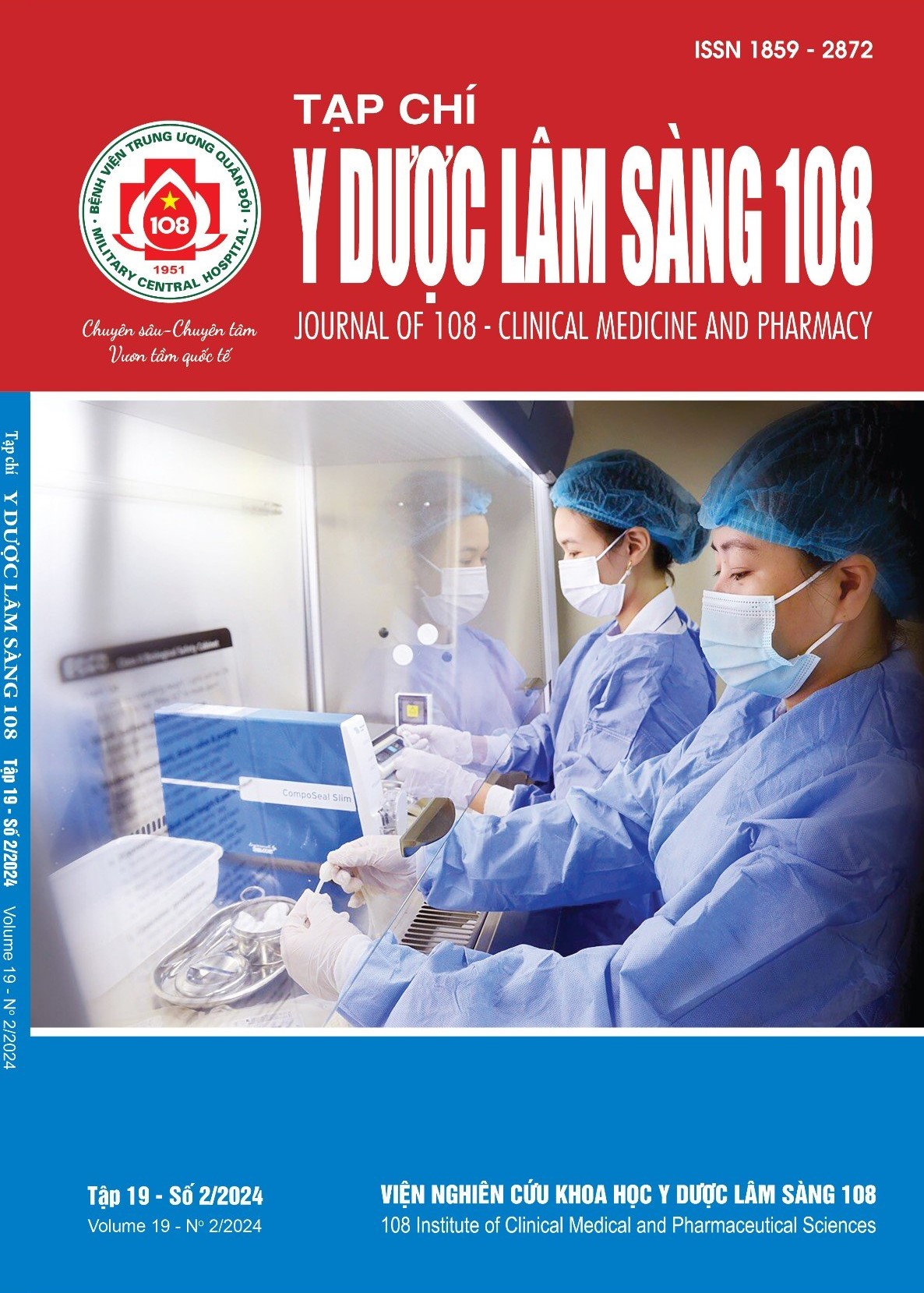Kết quả sử dụng antithymocyte globulin (ATG) dẫn nhập cho bệnh nhân ghép thận có nguy cơ miễn dịch thấp
Main Article Content
Keywords
Tóm tắt
Mục tiêu: Đánh giá kết quả sử dụng antithymocyte globulin (ATG) dẫn nhập cho bệnh nhân ghép thận có nguy cơ miễn dịch thấp. Đối tượng và phương pháp: Nghiên cứu mô tả tiến cứu, theo dõi dọc ở 40 bệnh nhân ghép thận có nguy cơ miễn dịch thấp, sử dụng ATG tại Bệnh viện Trung ương Quân đội 108 thời gian từ tháng 3/2023 đến tháng 01/2024. Kết quả: Chức năng thận ghép cải thiện rõ rệt với nồng độ creatinine huyết thanh và mức lọc cầu thận sau ghép ngày thứ 1 là 272,37mcmol/l và 34,78ml/phút/1,73m2, tháng thứ 3 là 102,7mcmol/l và 70,12ml/phút/1,73m2. Tỉ lệ chậm chức năng thận ghép là 7,5%, tỉ lệ thải ghép cấp là 7,5%, tỉ lệ phục hồi mảnh ghép và bệnh nhân là 100%. Tỉ lệ giảm bạch cầu là 10%, tỉ lệ nhiễm khuẩn tiết niệu là 17,5%, tỉ lệ nhiễm BK virus 17,5%, tỷ lệ nhiễm cytomegalovirus là 10%. Kết luận: ATG có hiệu quả và an toàn trong liệu pháp miễn dịch dẫn nhập cho bệnh nhân ghép thận có nguy cơ miễn dịch thấp.
Article Details
Các tài liệu tham khảo
2. Kidney Disease: Improving Global Outcomes (KDIGO) Transplant Work Group (2009) KDIGO clinical practice guideline for the care of kidney transplant recipients. Am J Transplant. 2009 Nov;9 Suppl 3:S1-155. doi: 10.1111/j.1600-6143.2009.02834.x. PMID: 19845597.
3. Hardinger KL, Brennan DC, Schnitzler MA (2009) Rabbit antithymocyte globulin is more beneficial in standard kidney than in extended donor recipients. Transplantation 87(9): 1372-1376.
4. Hong SY, Kim YS, Jin K et al (2023) The comparative efficacy and safety of basiliximab and antithymocyte globulin in deceased donor kidney transplantation:
A multicenter cohort study. Kidney Res Clin Pract 42(1): 138-148.
5. Kim SJ, Rhu J, Yoo H, Kim K, Lee KW, Park JB (2020) Outcome comparison between low-dose rabbit anti-thymocyte globulin and basiliximab in low-risk living donor kidney transplantation. Journal of clinical medicine 9(5).
6. Martinez-Mier G, Moreno-Ley PI, Budar-Fernández LF et al (2021) Low-dose thymoglobulin vs basiliximab induction therapy in low-risk living related kidney transplant recipients: a prospective randomized trial. Transplantation Proceedings 53(3): 1005-1009.
7. Ngoc TDT, Phuong DT, Diem TH, Tuan ADN, Van MB, Pham C (2016) Prevalence rate of CMV infection in patients after kidney transplantation in VietNam. EJPMR 3(5): 98-106.
8. Montero C, Yomayusa N, Torres R et al (2023) Low dose thymoglobulin versus basiliximab in cytomegalovirus positive kidney transplant recipients: Effectiveness of preemptive cytomegalovirus modified strategy. Nefrología (English Edition) 43(2): 213-223.
9. Thomusch O, Wiesener M, Opgenoorth M et al (2016) Rabbit-ATG or basiliximab induction for rapid steroid withdrawal after renal transplantation (Harmony): An open-label, multicentre, randomised controlled trial. Lancet (London, England) 388(10063): 3006-3016.
10. Hill P, Cross NB, Barnett AN, Palmer SC, Webster AC (2017) Polyclonal and monoclonal antibodies for induction therapy in kidney transplant recipients. The Cochrane database of systematic reviews 1(1): Cd004759.
11. Mourad G, Rostaing L, Legendre C, Garrigue V, Thervet E, Durand D (2004) Sequential protocols using basiliximab versus antithymocyte globulins in
renal-transplant patients receiving mycophenolate mofetil and steroids. Transplantation 78(4): 584-590.
 ISSN: 1859 - 2872
ISSN: 1859 - 2872
